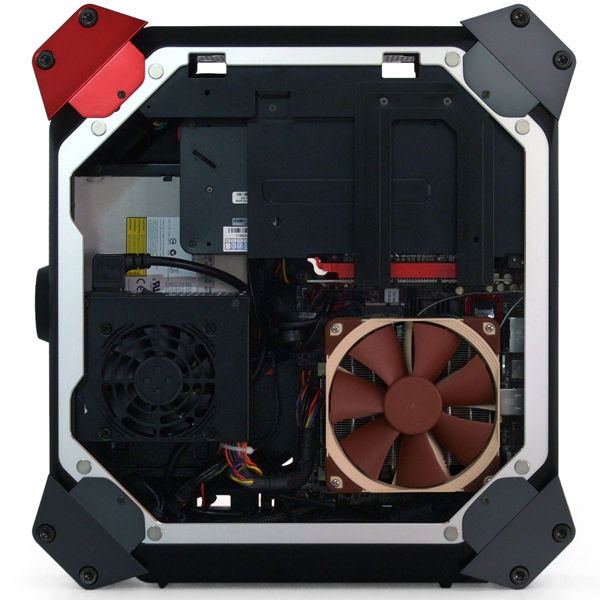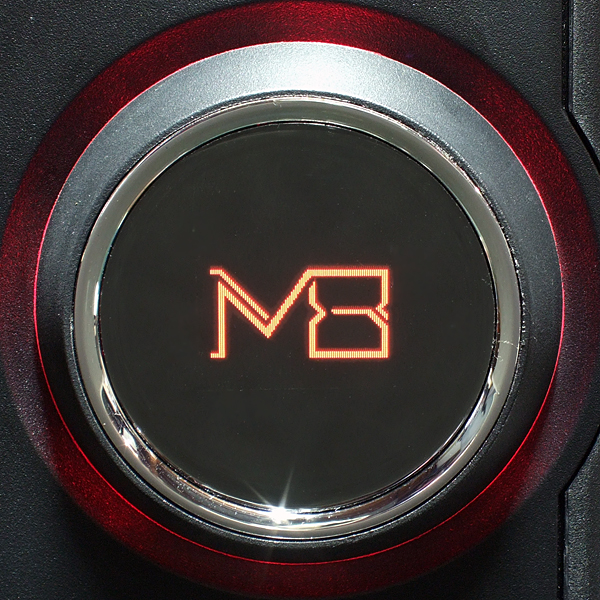ASRock M8 Mini-ITX Barebones Gaming PC Review
Some of us love compact gaming builds, but the best of these have always been pre-configured into custom enclosures. Is ASRock’s M8 the perfect open-architecture alternative? We load this $550 barebones up with hardware and test its mettle.
Overcoming A Significant Thermal Issue
Everything fits nicely, and we get an extra 10 mm of space between the fan and side panel to keep air flowing properly. Since the bottom panel's front fan is an intake and its rear fan an exhaust, we only hope that the exhaust fan is able to pull heat away from this cooler.
The side-panel windows have dark tint, inviting flashy users to install a lighted fan on their CPU cooler. My hopes of improved thermal performance prevented me from using the lighted fan supplied with my chosen CPU cooler.
The front-panel button features an OLED screen with system status monitoring, time, audio system volume, and power profile settings all available at the turn of a knob.


Unfortunately, our build did not end there. Even with a moderately-sized heat sink and oversized fan, the system throttled any time we ran the eight-thread AVX-optimized copy of Prime95 we like to use for burn-in. You might be tempted to call that an unrealistic or even unreasonable load, but we always test for worst-case scenarios. After all, who’s to say that someone won’t develop a similarly-stressful method to accelerate something practical, such as Folding@home?
Thermal throttling probably wouldn’t affect our benchmark suite, and I want that baseline to represent a stock configuration. Yet, before I could run any overclocking tests, I had to find a solution to the M8’s thermal issues. The most obvious answer would have been to pop a hole in its side panel over the CPU fan. That would have destroyed the enclosure's clean look, though. A platform test on an open bench showed that the case added at least 20 °C to CPU temperature, so it was time to reconsider ASRock's intake and exhaust configuration.
Both the top and bottom panel had fans configured as forward updraft and aft downdraft. ASRock's image shows how the power supply is supposed to get air from the lower updraft fan, the graphics card from the aft downdraft fan, and the CPU from...perhaps a hole in the side panel?
Since air follows the path of least resistance, it would appear that most of what was being drawn into the case was being expelled by the nearby exhaust fan before it could reach any internal components. To test my theory, I needed to make a couple of adjustments. The old saying that hot air rises is usually true because it's less dense. To take advantage of this phenomenon, I flipped the bottom exhaust and top intake fans. Both bottom fans were now intakes, both top fans were now exhaust, and all I needed to do was:
Get Tom's Hardware's best news and in-depth reviews, straight to your inbox.
- Completely gut the system, since the bottom panel is secured from the inside with four screws.
- And then slice up the wire sleeves, since the guide on each fan frame was farther apart.
CPU load temperature immediately dropped by roughly 20°, but at the expense of messier cabling.
The next problem was noise. Anyone with experience overclocking AMD's Athlons probably remembers the whine of 70 mm fans screaming at 4000 RPM. ASRock's M8 has four of these. Noise (at one meter) ranges from 31 to 49 dB(A) with all four fans running. What's more, the firmware's fan modes appear to only affect the temperature at which fan speed is increased within its 2000 to 4000 RPM range.
Disconnecting the top fans dropped idle noise by two decibels (to 29) and full-load noise by six (to 43) with only a 2 °C CPU temperature increase. That also means the two bottom-panel intake fans outperform the factory delivered four-fan split configuration in nearly every way imaginable. At least the problem is fixable!
Update October 28
ASRock has informed us that it has shipped the M8 with upgraded fans that have a wider RPM range, with an 800 RPM minimum, to reduce low-load noise. We can only hope that they also fix the fan direction.
A second look at the airflow diagram above appears to indicate that the chassis designer intended the CPU fan to receive air through vents in the side panel. The second photo from the top of this page shows that this side panel is molded with faux louvers. Actual louvers have slots, and modders would likely find additional cooling benefits by slotting these louvers.
Current page: Overcoming A Significant Thermal Issue
Prev Page Hardware Installation Next Page ASRock M8 Software-
lpedraja2002 ReplyThe old saying that hot air rises is usually true because it's less dense. To take advantage of this phenomenon, I flipped the bottom exhaust and top intake fans. Both bottom fans were now intakes, both top fans were now exhaust, and all I needed to do was:
Completely gut the system, since the bottom panel is secured from the inside with four screws.
And then slice up the wire sleeves, since the guide on each fan frame was farther apart.
CPU load temperature immediately dropped by roughly 20°, but at the expense of messier cabling.
Awesome way of thinking Thomas, that's why I love you guys. I am curious however to know if you emailed them to tell them about this solution. Since it made such a dramatic difference they should change the way those fans are positioned. -
second_exodous I'm looking into barebones to build a steam box and I'm finding they all have noise/thermal issues. I hope that Valve has a hand in some sort of certification program and hires their own engineers to test these barebone systems before giving the stamp of approval as a system to be used as a steam box. I'm also a Linux user and if they can clear up Linux compatibility for me that would also be great.Reply -
jestersage I hope this fans the flames of trend and others follow suit - so innovation goes up and prices go down. I like the M8. And Thomas gives it a very good once-over - including answers to some issues. Good job!Reply -
razzb3d Just remove the plexiglass window and replace it with a nice honeycomb metal mesh. Cooling problem solved.Reply -
Onus This case looks like a good idea, that just needs some refinement to make it even more generic. Another 10mm of thickness to allow 80mm fans (and possibly a full-size optical drive) could go a long way.Reply
Does the added trace length or extra connection required to use a riser card impose any kind of penalty on graphics cards? Please test this, by using one on a typical motherboard just for some measurements.
-
Crashman Reply
It doesn't need extra thickness to support the larger fans, just a minor redesign of the top and bottom panel. But the top panel redesign would include a different locking mechanism, so the tooling cost would be high.11789583 said:This case looks like a good idea, that just needs some refinement to make it even more generic. Another 10mm of thickness to allow 80mm fans (and possibly a full-size optical drive) could go a long way.
Does the added trace length or extra connection required to use a riser card impose any kind of penalty on graphics cards? Please test this, by using one on a typical motherboard just for some measurements.
-
thespaceduck Maybe it is just me, but doing 9 different test for "performance" for a CHASSIS seems redundant and obsolete.Reply -
crenwelge I purchased an ASRock mini-ITX HTPC that never worked. It continually blue screened and crashed. I sent it to ASRock 5 times for repair before finally giving up. Its technicians are either incompetent or dishonest . Once they sent it back with parts loose inside the case, another time without the power supply. Every time they claim to have tested it, but every time it came back blue-screening and crashing. Newegg refused to take it back and instead offered me a $100 credit. When I tried to use it, I found Newegg had deactivated my account. ASRock may be a competent motherboard house, but they cannot build and service reliable systems.Reply





